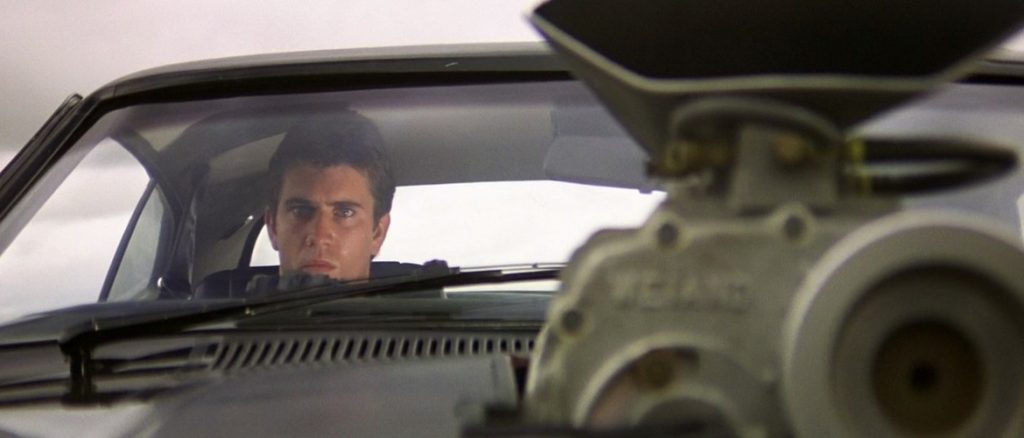Mad Max (1979)

An introduction hardly seems necessary for the granddaddy of modern post-apocalyptic action films, even if civilization is only on the world collapsing, not yet the barely habitable wasteland shown in the movies to come. It’s also the film that put its star, Mel Gibson, on the map as a leading man. Gibson was an inexperienced actor but did have training at the Australian Institute for Dramatic Arts. Pursuing acting for the theater stage and dabbled in TV primarily, Gibson had appeared in one film part only, Summer City, a side job while still in school a couple of years prior to Mad Max. He was discovered by Miller when he was dropping off a fellow actor for an audition.
Set in the near future (the words on the screen say, “A few years from now”), Gibson stars as the titular Max, one of the best police officers working for the MFP (Main Force Patrol) fighting against the increasingly hostile lands, full of marauding car and biker gangs who have no regard for life, or for laws, and especially not for law officers. One such gang of bikers, led by a psychopath named Toecutter, is on the rampage and is targeting MFP officers who’ve messed with their way of doing things, putting them all in potential harm’s way. A family man, Max doesn’t know if he’s really cut out to put his neck on the line in a losing battle against anarchy. He soon discovers there is not much escape from the criminal element that has permeated everywhere, and it’s kill or be killed in the lawless and bloodthirsty territories.
Directed by former emergency room doctor George Miller, his debut effort, Mad Max is a low-budget (around $350k, shot guerrilla-style outside of the city of Melbourne), Corman-esque actioner from a fledgling Australian film industry that hadn’t been getting the distribution and recognition it had deserved. This was a huge smash in its native country and would make in-roads for Aussie cinema in many other parts of the world henceforth, after setting a world record for the money it netted at the world box office above its budget, not broken until twenty years later with the release of The Blair Witch Project. In the United States, however, it wasn’t treated as kindly, relegated to a very limited release schedule, and over-dubbed by the North American distributor, American International Pictures, with the use of American voice actors (including the American-born Mel Gibson himself) to make the dialogue and slang understandable to a movie-going public unaccustomed to Australian accents.
Miller directs this futuristic thriller with the eye toward spaghetti westerns, with its gritty anti-hero, sadistic outlaws, and wide shot compositions that one rarely sees outside of the genre. The tracking shots from the first-time cinematographer David Eggby, whether on the road or on the land, are stunning to behold, not only giving the feeling of fluidity and fast action but also showing that there is truly no place to run and nowhere to hide in the vastness of the outback. Miller, who originally conceived the film as a precautionary fable on the dangers of reckless driving, would use his skills as a doctor who regularly treated injuries from firearms and car accidents to effectively create the realistic-looking damage done to the human bodies within the film. Miller’s education as a doctor floated into the writing of the movie, as Max’s last name of Rockatansky is based on noted real-life Austrian physician Carl von Rokitansky.
Brilliant use of locales in the desolate, Australian outback. But what really elevates Mad Max above being just a run-of-the-mill Western in cars is the jaw-dropping stunt work coordinated by Grant Page, which rivals many big Hollywood efforts at the time. Real-life stuntmen were rarely used, with a real-life crazy, fast-driving biker gang called the Vigilanties portraying most of Toecutter’s gang. Many of the cast, especially the extras, were paid in beer (rather than monetarily) for their participation and the use of their vehicles on the roads.
The story is fairly simple, but it does arrest the attention during the conflicts because of the way Miller subverts formula thriller elements, prolonging the conflicts into the next scene, then the next, and even calling back to previous ones. Nothing is tidy, which give the movie edge and unpredictability. It’s a bit rough around those edges, to the point where I wouldn’t deem it a great movie overall, especially since, unlike Sergio Leone’s spaghetti westerns, the score is often incongruous with the nature of the movie, and drowns out the dialogue on occasion. If it were possible to re-release the film with a newly composed score, I’d pay top dollar to see how much of an effect it has on the overall vibe.
Avoid the cartoonishly dubbed American version. The Aussie accents are not even close to being incomprehensible, contrary to what the North American distributors may have thought at the time
Qwipster’s rating: B
MPAA Rated: R for violence, brief language, and some sexuality.
Running Time: 88 min. (video releases typically run 93 min.)
Cast: Mel Gibson, Joanne Samuel, Steve Bisley, Hugh Keays-Byrne, Tim Burns, Roger Ward, Vince Gil
Director: George Miller
Screenplay: James McCausland, George Miller
